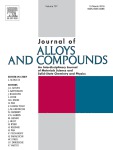Molybdenum incorporation on AB2 alloys-Part II. On the synergetic effects of Laves and non-Laves phases
Dublin Core
Título
Molybdenum incorporation on AB2 alloys-Part II. On the synergetic effects of Laves and non-Laves phases
Tema
MOLIBDENO
ALEACIONES
SINERGIA
BIBLIOGRAFIA NACIONAL QUIMICA
2018
Abstract
Molybdenum substitution by chromium in ZrCr1-xNiMox alloys produces the segregation of ZrxNiy phases, ZrCr2 and ZrMo2 Laves phases as it was stated in Part I of this paper. In order to study the contribution of these phases in ZrCr1-xNiMox alloys performance, secondary Zr9Ni11 and Zr7Ni10, together with ZrCr2 and ZrMo2 Laves phases were synthesized and their crystalline structures determined with XRD patterns. Zr7Ni10 exhibits an orthorhombic structure, whereas Zr9Ni11 depicts a tetragonal structure. ZrCr2 presents a hexagonal structure (C14), while ZrMo2 depicts a cubic structure (C15). ZrCr2 shows zero discharge capacities, while ZrMo2 exhibits a first capacity value of 245 mAh g−1. Zr9Ni11 and Zr7Ni10 phases exhibit maximum discharge capacities of 119 and 157 mAh g−1, respectively. Theoretical results show that the hydride stability for ZrCr2 is larger than that for ZrMo2. However, the great hydrogen storage capacity yields a slower desorption kinetics since it requires a considerable de-hydrogenation energy. The opposite effect is observed for the proposed hexagonal structure ZrMo2. The 100% charge of the alloys shows different results for the hydrogen evolution reaction. Zr7Ni10 phase depicts a better performance since the required potentials are lower than −1.05 V. There is a change in the rate determining step (rds) from a chemical recombination of surface hydrogen (Tafel pathway) in Zr7Ni10 to a fast first electron transfer (Volmer step) for Zr9Ni11. Thus, the rds is strongly affected by the type of secondary phase dominant in each sample, being Zr7Ni10 the most favorable.
Autor
Teliz, Erika
Diez, Joaquín
German, Estefania
Zinola Sánchez, Carlos Fernando.
Díaz, Verónica
Fuente
Journal of Alloys and Compounds v. 737, 2018. -- p. 530-535
Editor
Elsevier
Fecha
2018
Derechos
Información sobre Derechos de Autor (Por favor lea este aviso antes de abrir los documentos u objetos) La legislación uruguaya protege el derecho de autor sobre toda creación literaria, científica o artística, tanto en lo que tiene que ver con sus derechos morales, como en lo referente a los derechos patrimoniales con sujeción a lo establecido por el derecho común y las siguientes leyes (LEY 9.739 DE 17 DE DICIEMBRE DE 1937 SOBRE PROPIEDAD LITERARIA Y ARTISTICA CON LAS MODIFICACIONES INTRODUCIDAS POR LA LEY DE DERECHO DE AUTOR Y DERECHOS CONEXOS No. 17.616 DE 10 DE ENERO DE 2003, LEY 17.805 DE 26 DE AGOSTO DE 2004, LEY 18.046 DE 24 DE OCTUBRE DE 2006) ADVERTENCIA - La consulta de este documento queda condicionada a la aceptación de las siguientes condiciones de uso: Este documento es únicamente para usos privados enmarcados en actividades de investigación y docencia. No se autoriza su reproducción con fines de lucro. Esta reserva de derechos afecta tanto los datos del documento como a sus contenidos. En la utilización o cita de partes debe indicarse el nombre de la persona autora.
Formato
PDF
Idioma
Inglés
Tipo
Artículo
Identificador
DOI: 10.1016/j.jallcom.2017.12.103
Document Item Type Metadata
Original Format
PDF
- Fecha de agregación
- November 1, 2018
- Colección
- Bibliografía Nacional Química
- Tipo de Elemento
- Document
- Etiquetas
- Aleaciones, Molibdeno, Sinergia
- Citación
- Teliz, Erika, “Molybdenum incorporation on AB2 alloys-Part II. On the synergetic effects of Laves and non-Laves phases,” RIQUIM - Repositorio Institucional de la Facultad de Química - UdelaR, accessed July 26, 2024, https://riquim.fq.edu.uy/items/show/5323.
- Archivos

